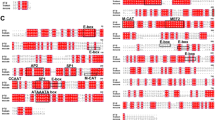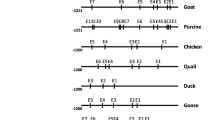Abstract
Myostatin belongs to the Transforming Growth Factor-β ((TGF-β) superfamily and is expressed in developing and mature skeletal muscle. Biologically, the role of myostatin seems to be extremely well conserved during evolution since inactivating mutations in myostatin gene cause similar phenotype of heavy muscling in both mice and cattle. In this report we have analysed the genomic structure and neonatal expression of the bovine myostatin gene. The molecular analysis shows that the bovine myostatin gene consists of three exons and two introns. The sizes of the first and second exons are 506 and 374 base pairs (bp) respectively. The size of the third exon was found to be variable in length (1701 or 1812 or 1887 nucleotides), whereas the size of the two introns is 1840 and 2033 bps. In the first exon of bovine myostatin, a single transcription initiation site is found at 133 bps from the translation start codon ATG. Sequencing the 3′ untranslated region indicated that there are multiple polyadenylation signals at 1301, 1401 and 1477 bp downstream from the translation stop codon (TGA). Furthermore, 3′ RACE analysis confirmed that all three polyadenylation sites are used in vivo. Using quantitative RT-PCR we have analysed neonatal expression of myostatin gene. In both the M. biceps femoris and M. semitendinosus, the highest level of myostatin expression was observed on day 1 postnatally, then gradually reduced on days 8 and 14 postnatally. In contrast, in the M. gastrocnemius, myostatin expression was highest on day 14 and lowest on day 8. These results indicate that myostatin gene structure and function is well conserved during evolution and that neonatal expression of myostatin in a number of predominantly fast twitch muscles is differentially regulated.
Similar content being viewed by others
References
McPherron AC, Lawler AM, Lee S-J: Regulation of skeletal muscle mass in mice by a new TGF-β superfamily member. Nature 387: 83–90, 1997
Kambadur R, Sharma M, Smith TPL, Bass JJ: Mutations in myostatin (GDF8) in double-muscled Belgian Blue and Piedmontese cattle. Genome Res 7: 910–915, 1997
Grobet L, Martin LJR, Poncelet D, Pirottin D, Brouwers B, Riquet J, Schoeberlein A, Dunner S, Menissier F, Massabanda J, Fries R, Hanset R, Georges M: A deletion in the bovine myostatin gene causes the double-muscled phenotype in cattle. Nat Genet 17: 71–74, 1997
McPherron AC, Lee S-J: Double muscling in cattle due to mutations in the myostatin gene. Proc Natl Acad Sci USA 94: 12457–12461, 1997
Grobet L, Poncelet D, Royo LJ, Brouwers B, Pirottin D, Michaux C, Menissier F, Zanotti M, Dunner S, Georges M: Molecular definition of an allelic series of mutations disrupting the myostatin function and causing double-muscling in cattle. Mamm Genome 9: 210–213, 1998
McPherron AC, Lee S-J: The transforming growth factor-b superfamily. In: D. LeRoith, C. Bondy (eds). Growth Factors and Cytokines in Health and Disease, vol. 1B. JAI Press Inc., Greenwich. 1996, pp 357–393
Sharma M, Kambadur R, Matthews KG, Somers WG, Devlin GP, Conaglen JV, Fowke PJ, Bass JJ: Myostatin, a transforming growth factor-b superfamily member, is expressed in heart muscle and is upregulated in cardiomyocytes after infarct. J Cell Physiol 180: 1–9, 1999
Ji S, Losinski RL, Cornelius SG, Frank GR, Willis GM, Gerrard DE, Depreux FS, Spurlock ME: Myostatin expression in porcine tissues: Tissue specificity and developmental and postnatal regulation. Am J Physiol 275: R1265–R1273, 1998
Sambrook A, Fritsch, EF, Maniatis T: In: Molecular Cloning A Laboratory Manual. Cold Spring Harbor Laboratory Press, Cold Spring Harbor, New York, 1989, pp 9.4–9.59
Gause WC, Adamovicz J: Use of PCR to quantitate relative differences in gene expression. In: C.W. Dieffenback, G.S. Dveksler (eds). PCR Primer. A Laboratory Manual. CSHL Press, Cold Spring Harbor, New York, USA, 1995, pp 293–311
Sharp PA: Speculations on RNA splicing. Cell 23: 643–646, 1981
Gonzalez-Cadavid NF, Taylor WE, Yarasheski K, Sinha-Hikim I, Ma K, Ezzat S, Shen R, Lalani L, Asa S, Mamita M, Nair G, Arver S, Bhasin S: Organization of the human myostatin gene and expression in healthy men and HIV-infected men with muscle wasting. Proc Natl Acad Sci USA 95: 14938–14943, 1998
Sharma M, Martyn JK, Jeanplong F, Thomas M, Spiller MP, Bass JJ, Kambadur R: Cloning and characterization of the bovine myostatin promoter: Regulation by the myogenic regulatory factors. Mol Biol Musc Dev Dis, 2000
Author information
Authors and Affiliations
Corresponding author
Rights and permissions
About this article
Cite this article
Jeanplong, F., Sharma, M., Somers, W.G. et al. Genomic organization and neonatal expression of the bovine myostatin gene. Mol Cell Biochem 220, 31–37 (2001). https://doi.org/10.1023/A:1010801511963
Issue Date:
DOI: https://doi.org/10.1023/A:1010801511963




